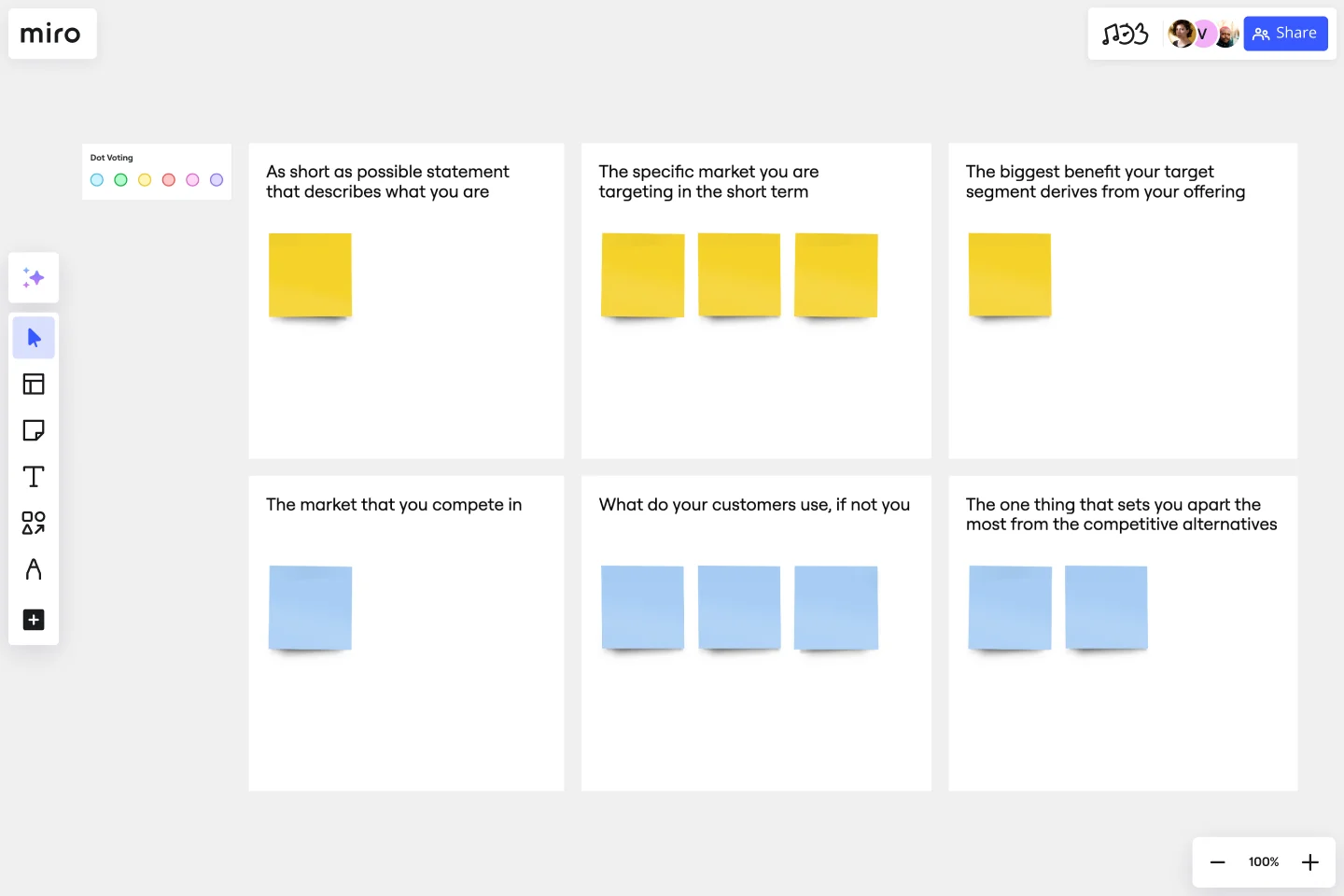Product Positioning Template
Create your strategy for launching a new product or entering a new market with the product positioning template.
About the Product Positioning Template
The success of your company largely depends on the market you are operating in. So, it is necessary to conduct a product positioning exercise before you start building products and planning strategies. This exercise is intended to determine where your company and its offering stands in the market. Although the format of these exercises may differ, it is generally advised to have these objectives in mind:
Define your customer: Who would buy your product or service?
Define the problem: What pain point are you solving for your customer? How does this problem impact your customers? It can also be useful to think about your customers’ experience of this problem. What emotions might they feel when they encounter the problem? This will help you market and design your product offering.
Define key market characteristics: What else do your customers usually buy? How do they buy it? What makes them switch products?
List the other companies in your market: Are these companies your potential partners? Potential competitors? What is their business model? How have they been successful? How have they failed? What is their biggest pain point?
Design an elevator pitch: Your pitch should encompass your customers, their pain points, and how your product is uniquely positioned to solve their problem.
Narrow down your competitors: Now that you have your pitch list your competitors and their strengths and weaknesses relative to your offering.
How to use the product positioning template
The product positioning template is fully customizable, so you can adapt it to your specific needs. Here is a step-by-step on how to use the template:
Step 1: Invite your team members to collaborate on your board.
Step 2: Add the product positioning template. Brainstorm and upload all relevant information to add to each section of the template.
Step 3: If needed, use a Talktrack to share ideas beforehand, and start discussions with your colleagues async.
Step 4: Gather your findings and organize your final product positioning.
Step 5: Present your product positioning directly from the board, print them out, or share them with other stakeholders to gather their feedback.
When should you conduct product positioning exercises?
It is recommended to carry out product positioning exercises whenever launching a new product or entering a new market. Additionally, it is advisable to periodically conduct product positioning to keep up-to-date with the market trends and to stay informed about your product.
Get started with this template right now.
App Development Canvas Template
Works best for:
Market Research, Product Management, User Experience
Ever noticed that building a successful app requires lots of players and moving parts? If you’re a project manager, you definitely have. Lucky for you, an app development canvas will let you own and optimize the entire process. It features 18 boxes, each one focusing on a key aspect of app development, giving you a big-picture view. That way you can fine-tune processes and get ahead of potential problems along the way—resulting in a smoother path and a better, tighter product.
Customer Problem Statement Template
Works best for:
Ideation, Design Thinking, Product Management
Put yourself in the shoes of your consumers with a customer problem statement. Figure out their problems and how your product or service can solve those problems and make their lives easier. As a bonus, you’ll better understand your customers throughout the process.
Four-Circle Venn Diagram
Works best for:
Venn Diagram
The Four Circle Venn Diagram template is designed for comparing four sets of data. Use this tool to identify commonalities and differences across multiple categories. This template is ideal for complex data analysis, strategic planning, and academic research. It helps you visually organize information, making it easier to understand and communicate insights. Perfect for educators, researchers, and professionals in need of detailed comparison tools.
Meeting Organizer Template
Works best for:
Meetings, Workshops, Project Planning
When it comes to ideas generated during a meeting, you want quantity AND quality. So why choose? Our meeting organizer template will maximize your meeting’s chances of yielding lots of great ideas. It will give you a simple, efficient way to design any activity (including meetings and daily planning) and make sure remote teammates know just what the meeting aims to accomplish. And you can give your meeting organizer power by connecting Miro to your favorite apps and services: Atlassian’s JIRA, Google Drive, Slack, Trello, DropBox and OneDrive.
Startup Canvas Template
Works best for:
Leadership, Documentation, Strategic Planning
A Startup Canvas helps founders express and map out a new business idea in a less formal format than a traditional business plan. Startup Canvases are a useful visual map for founders who want to judge their new business idea’s strengths and weaknesses. This Canvas can be used as a framework to quickly articulate your business idea’s value proposition, problem, solution, market, team, marketing channels, customer segment, external risks, and Key Performance Indicators. By articulating factors like success, viability, vision, and value to the customer, founders can make a concise case for why a new product or service should exist and get funded.
Fishbone Diagram for Marketing
Works best for:
Fishbone Diagram
Optimizing marketing strategies requires identifying underlying issues. The Fishbone Diagram Marketing template helps you systematically explore factors affecting your campaigns. Categorize potential causes into areas such as market research, product positioning, promotional strategies, and distribution channels. This structured analysis enables your team to pinpoint and address issues, enhancing marketing effectiveness and achieving better results.
